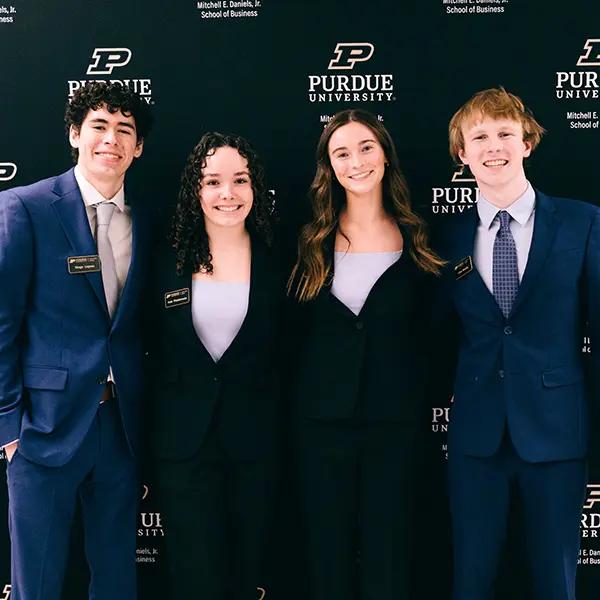
The benefits of experiential learning opportunities like case competitions are well-documented, from applying business concepts and analytics to real-word challenges to honing an arsenal of presentation skills that illustrates a solution. At the center of it all is teamwork and collegiality — the ability to leverage one another’s strengths in pursuit of a common goal.
Those dynamics recently came into play for a group of freshmen from the Larsen Leaders Academy who combined efforts to win this spring’s annual PowerShift Case Competition, which this year focused on attracting and retaining more women to the semiconductor industry. The event was sponsored by the Brock-Wilson Center for Women in Business at Purdue University’s Mitchell E. Daniels, Jr. School of Business.
“There’s a growing body of research that recognizes companies perform better when they have diversity in their leadership,” says Cara Putman, director of the Brock-Wilson Center. “We need the different perspectives and insights that women and minorities bring to companies and teams. That’s why we decided to have students tackle the real challenge of diversity in the semiconductor industry. Who better to consider new ways of recruiting talent than students who aren’t encumbered by the ways we’ve always done things or the constraints we impose on ourselves?”
Calling itself Integrated Solutions, the winning team was comprised of marketing major Emma Ahern and finance majors Ethan Murphy, Kate Fitzsimmons and Diego Legoas. They were tasked with developing a workforce strategy that a fictional company could deploy in strengthening its relationships with key stakeholders at the Indiana Economic Development Corporation, the Department of Commerce and Purdue University.
“When first receiving the case, we grappled with how broad our target audience should be for each of our solutions,” says Murphy. “We questioned whether we should focus solely on the company written in the case, or if we should take a broader approach. Ultimately, choosing to look at the bigger picture enabled us to differentiate our solutions from the competition. We achieved this by not only factoring in the target company, but also tailoring our solutions to benefit the state of Indiana as a whole.
“Our team addressed the issue of ‘brain drain’ within Indiana, developing a comprehensive solution aimed at retaining educated semiconductor professionals within the state for longer periods of time. This broader perspective also allowed us to better incorporate some of the large stakeholders like the IEDC and the Department of Commerce. By exploring topics and issues past what was directly written in the case, we were able to enhance the quality of our solutions greatly.”

Ahern says the team of first-year students’ approach to the case drew directly from their classroom learning. “Throughout the competition, the experiences we’ve had individually throughout our academic careers contributed greatly to our success,” she says. “We all learned a lot about the process of researching, finding accurate information, and the importance of formulating conclusions based on those findings. The experience of working as a team towards one common goal also made the importance of communication and time management clear.”
The team’s biggest takeaway from the experience was the importance of hard work. “There were many times when we were worried that we had not made enough progress," Fitzsimmons says. “But as we neared the final days of the competition, we realized that each time we had to completely scrap an idea or pivot to a new direction, we were actually getting another step closer to our final solution. We pushed past the mental strain of forming new ideas and were able to build on the original solutions, expanding on what worked best.”
The experience also resulted in an unexpected benefit — friendship.
“Before the competition, most of our teammates had not held a single conversation with one another. We had no idea how our chemistry would be or how our personalities would mesh,” Legoas says. “But we are now close friends and continue to meet each week for dinner. Watching one another tackle different issues and come up with different solutions created a joyful environment where bonding was inevitable. We clicked, and once that bond formed, there was no stopping us.”